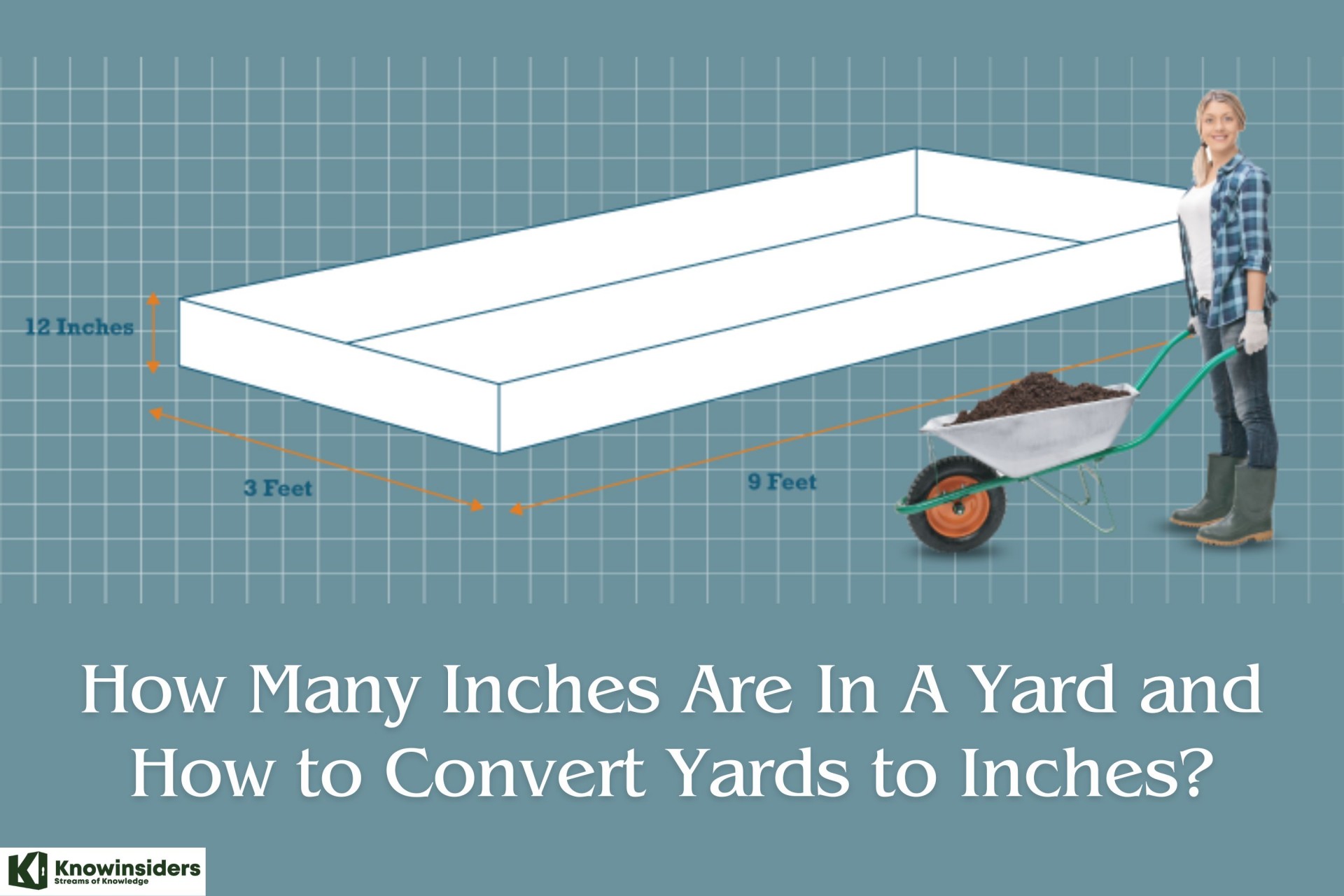How to Convert Feet to Inches and Inches to Feet: Simple Ways to Change
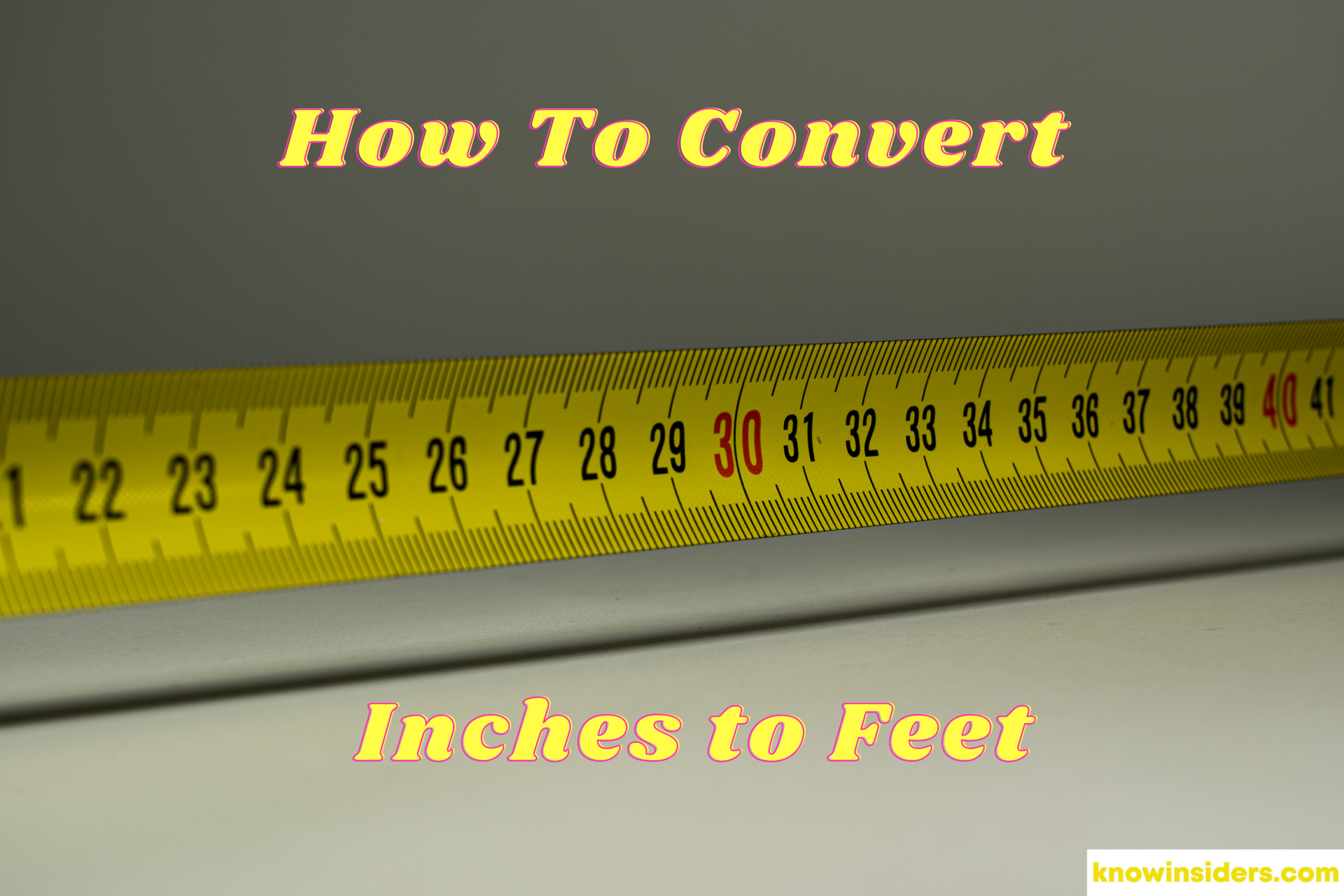 |
| Convert Feet to Inches and Inches to Feet - Photo KnowInsiders |
Feet (ft) and inches (in) are two units of length, most commonly used in the United States. The units are used in schools, daily life, art, and some areas of science and engineering. The feet to inches conversion is useful and important, so here's the formula and examples that show how to convert feet to inches and inches to feet.
What is 'feet'?
The foot (pl. feet), standard symbol: ft is a unit of length in the British imperial and United States customary systems of measurement. The prime symbol, ′, is a customarily used alternative symbol. Since the International Yard and Pound Agreement of 1959, one foot is defined as 0.3048 meters exactly. In customary and imperial units, one foot comprises 12 inches and one yard comprises three feet.
Historically the "foot" was a part of many local systems of units, including the Greek, Roman, Chinese, French, and English systems. It varied in length from country to country, from city to city, and sometimes from trade to trade. Its length was usually between 250 mm and 335 mm and was generally, but not always, subdivided into 12 inches or 16 digits.
What is 'inch'?
The inch (symbol: in or ″) is a unit of length in the British imperial and the United States customary systems of measurement. It is equal to 1/36 or 1/12 of a foot. Derived from the Roman uncia ("twelfth"), the word inch is also sometimes used to translate similar units in other measurement systems, usually understood as deriving from the width of the human thumb.
Standards for the exact length of an inch have varied in the past, but since the adoption of the international yard during the 1950s and 1960s it has been based on the metric system and defined as exactly 25.4 mm.
Feet to Inches Formula
This conversion isn't quite as easy as converting between metric units, which are simply factors of 10, but it's not difficult.
| The conversion factor is: 1 foot = 12 inches distance in inches = (distance in feet) x (12 inches/foot) |
So, to convert a measurement in feet to inches, all you need to do is multiply the number by 12. This is an exact number, so if you're working with significant figures, it won't limit them.
Feet to Inches Example
Let's say you measure a room and find it is 12.2 feet across. Find the number in inches.
| length in inches = length in feet x 12 length = 12.2 ft x 12 length = 146.4 or 146 inches |
Feet to inches conversion table
| Feet (ft) | Inches (") |
|---|---|
| 0.01 ft | 0.12 ″ |
| 0.1 ft | 1.2 ″ |
| 0.2 ft | 2.4 ″ |
| 0.3 ft | 3.6 ″ |
| 0.4 ft | 4.8 ″ |
| 0.5 ft | 6.0 ″ |
| 0.6 ft | 7.2 ″ |
| 0.7 ft | 8.4 ″ |
| 0.8 ft | 9.6 ″ |
| 0.9 ft | 10.8 ″ |
| 1 ft | 12 ″ |
| 2 ft | 24 ″ |
| 3 ft | 36 ″ |
| 4 ft | 48 ″ |
| 5 ft | 60 ″ |
| 6 ft | 72 ″ |
| 7 ft | 84 ″ |
| 8 ft | 96 ″ |
| 9 ft | 108 ″ |
| 10 ft | 120 ″ |
| 100 ft | 1200 ″ |
Converting Inches to Feet
Since all you do is multiply by 12 to convert feet to inches, it should make sense to you that all you do to convert inches to feet is divide by 12.
| The conversion factor is the same: 12 inches = 1 foot distance in feet = (distance in inches) / (12 inches/foot) |
Inches to Feet Example
You measure your laptop and find the screen is 15.4 inches across. What is this in feet?
| distance in feet = (distance in inches) / (12 inches/foot) distance = 15.4 in / 12 in/ft distance = 1.28 feet |
Important Information for Unit Conversions with DivisionOne of the most common areas of confusion when doing unit conversions involving division concerns unit cancelling. When you're converting inches to feet, you divide by 12 in/ft. This is the same as multiplying by ft/in! It's one of those rules you use when multiplying fractions that a lot of people forget about when dealing with units. When you divide by a fraction, the denominator (part on the bottom) moves to the top, while the numerator (part on the top) moves to the bottom. Thus, the units cancel out to give you the desired answer. |
Inches to feet conversion table
| Inches (") | Feet (ft) |
|---|---|
| 0.01 ″ | 0.000833333 ft |
| 1/64 ″ | 0.001302083 ft |
| 1/32 ″ | 0.002604167 ft |
| 1/16 ″ | 0.005208333 ft |
| 0.1 ″ | 0.008333333 ft |
| 1/8 ″ | 0.010416667 ft |
| 1/4 ″ | 0.020833333 ft |
| 1/2 ″ | 0.041666667 ft |
| 1 ″ | 0.0833 ft |
| 2 ″ | 0.1667 ft |
| 3 ″ | 0.2500 ft |
| 4 ″ | 0.3333 ft |
| 5 ″ | 0.4167 ft |
| 6 ″ | 0.5000 ft |
| 7 ″ | 0.5833 ft |
| 8 ″ | 0.6667 ft |
| 9 ″ | 0.7500 ft |
| 10 ″ | 0.8333 ft |
| 20 ″ | 1.6667 ft |
| 30 ″ | 2.5000 ft |
| 40 ″ | 3.3333 ft |
| 50 ″ | 4.1667 ft |
| 60 ″ | 5.0000 ft |
| 70 ″ | 5.8333 ft |
| 80 ″ | 6.6667 ft |
| 90 ″ | 7.5000 ft |
| 100 ″ | 8.3333 ft |
How to Convert Feet to Inches, and Vice Versa in Excel
Manual approach
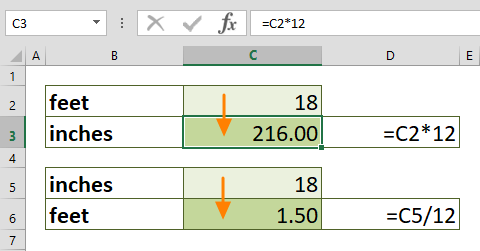 |
| Photo SpreadSheetWeb |
The first approach we are going to show you is doing the conversion manually. You can convert feet to inches using a simple math calculation. 1 foot is equal to 12 inches. Thus, you need to multiply the foot-value by 12 to get the same value in inches.
Let's say the cell C2 contains the foot-value. Use the formula below to find the inch-value.
In a similar way, you can convert feet to inches. As you can see in the above example, dividing an inch-value by 12 returns the value in feet. If we assume that the cell C5 contains the inch-value, the conversion formula would be something like =C5/12.
Now, let's take a look at more dynamic and relatively easy to remember approaches.
Using the CONVERT Function
Another way to convert feet to inches is using the CONVERT function. The CONVERT function can convert a number from one measurement system to another. The best part is that the function is not limited to only length units. You can convert weight, distance, temperature and more units of measurements between each other.
Briefly, you need to supply the value and both measurement types into the function. Excel accepts string abbreviations of the measurement types. In this example you can use:
Foot: "ft"
Inch: "in"
As a result, to convert the value in cell B5, you can use a formula like below:
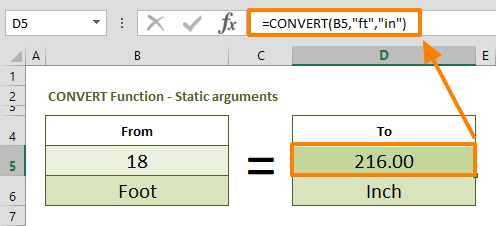 |
| Photo SpreadSheetWeb |
To make the conversion in the opposite direction, simply switch the measurement arguments. The following formula converts the value from inches to feet.
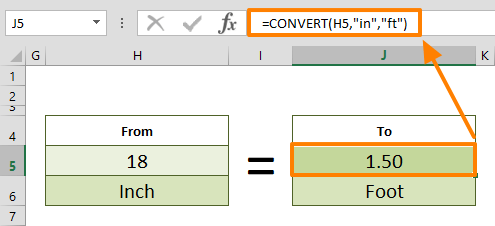 |
| Photo SpreadSheetWeb |
Another dynamic method
You can set cell references for unit arguments. This application allows you to control the from and to unit types. We combined the CONVERT and VLOOKUP functions to create a master formula which gets units to convert from a list or any other input type. With the help of the VLOOKUP function, we can use user-friendly names for unit type codes. For example, "feet" for "ft" and "inches" for "in".
The VLOOKUP function returns the corresponding unit type for the CONVERT function. Here is what the formula would look like:
=CONVERT(B11,VLOOKUP(B12,Length.Table,2,0),VLOOKUP(D12,Length.Table,2,0))
The cells B12 and D12 contains a dropdown list which contains length type of measurement units like "Feet" and "Inch" strings. The VLOOKUP function searches them in named range Length.Table and returns the corresponding value.
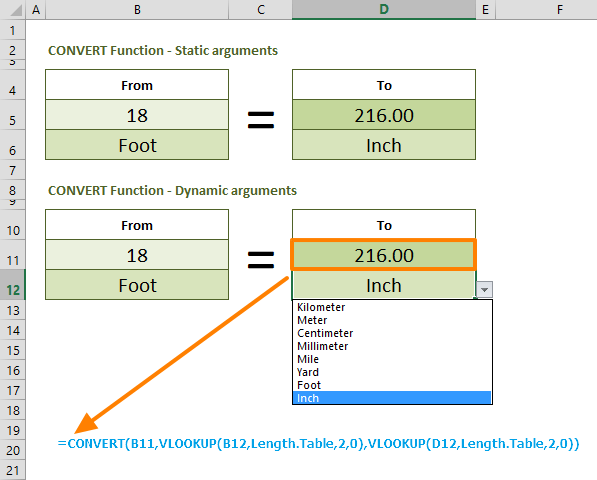 |
| Photo SpreadSheetWeb |
 Top 7 Longest Bridges in the America Top 7 Longest Bridges in the America Find out the top 7 longest bridges across America - the world's largest national economy. |
 Top 7 Longest Rivers in The World Top 7 Longest Rivers in The World The world features some amazingly long rivers but which are the longest? Check out our list of the top seven longest rivers in the world. |
 Longest Bridge in the World: Danyang–Kunshan Grand in China with 114 km Longest Bridge in the World: Danyang–Kunshan Grand in China with 114 km The world's longest bridges: tantalizing to some, terrifying to others, a long bridge over water is undoubtedly an engineering marvel. |



